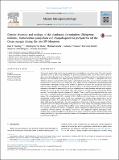Files in this item
Genetic diversity and ecology of the planktonic foraminifers Globigerina bulloides, Turborotalita quinqueloba and Neogloboquadrina pachyderma off the Oman margin during the late SW Monsoon
Item metadata
| dc.contributor.author | Darling, Kate F. | |
| dc.contributor.author | Wade, Christopher M. | |
| dc.contributor.author | Siccha, Michael | |
| dc.contributor.author | Trommer, Gabriele | |
| dc.contributor.author | Schulz, Hartmut | |
| dc.contributor.author | Abdolalipour, Samereh | |
| dc.contributor.author | Kurasawa, Atsushi | |
| dc.date.accessioned | 2017-11-27T09:30:12Z | |
| dc.date.available | 2017-11-27T09:30:12Z | |
| dc.date.issued | 2017-12 | |
| dc.identifier | 251423776 | |
| dc.identifier | d1559220-d27a-438c-8eb4-b740627eb887 | |
| dc.identifier | 85033577102 | |
| dc.identifier | 000417670800005 | |
| dc.identifier.citation | Darling , K F , Wade , C M , Siccha , M , Trommer , G , Schulz , H , Abdolalipour , S & Kurasawa , A 2017 , ' Genetic diversity and ecology of the planktonic foraminifers Globigerina bulloides , Turborotalita quinqueloba and Neogloboquadrina pachyderma off the Oman margin during the late SW Monsoon ' , Marine Micropaleontology , vol. 137 , pp. 64-77 . https://doi.org/10.1016/j.marmicro.2017.10.006 | en |
| dc.identifier.issn | 0377-8398 | |
| dc.identifier.other | RIS: urn:19015E5244F2AC3CC582B33E84D406A5 | |
| dc.identifier.uri | https://hdl.handle.net/10023/12173 | |
| dc.description | The molecular work was funded by an Advanced Fellowship award to K. Darling (UK Natural Environment Research Council (NERC); NER/J/S/2000/00860 and NE/D009707/1). SA received support from a DAAD fellowship (A0998101) and HS was supported by a DFG grant (SCHU 1605/2-1). | en |
| dc.description.abstract | The tropical waters of the Arabian Sea are among the richest biological areas of the world. The highly complex monsoonal system is particularly challenging for palaeoenvironmental study, which relies heavily upon understanding the modern-day ecology of planktonic foraminiferal assemblages and their geochemical signatures throughout the monsoonal cycle. Major upwelling responders such as G. bulloides, T. quinqueloba and N. pachyderma, typically associated with cooler mid to higher latitude ecosystems, are also found in number in the tropical Arabian Sea. Due to the more usual cooler water affinity of these morphospecies, the oceanographically isolated tropical upwelling ecosystem of the Arabian Sea potentially harbours new ecologically distinct genotypes (ecotypes). Samples were collected off the Oman margin at 15 stations towards the end of the summer monsoon to determine the genetic profiles of these morphospecies in both upwelling and open ocean regimes. Phylogenetic analysis of their small subunit (SSU) rDNA sequences revealed several new genetically distinct ecotypes. Two genetically divergent ecotypes of G. bulloides (Types Ia and IIf) were identified along the cruise track. Type Ia, a member of the G. bulloides warm water lineage, was found in both the upwelling and open ocean regions. The second genotype (IIf), a member of the G. bulloides cool water lineage, was found only in more marginal late upwelling cooler waters. Initial visual assessment of G. bulloides images suggests that it may be morphologically cryptic. Two highly divergent genotypes of T. quinqueloba (Types Ib and IIe) were also identified, which were largely confined to the eastern and northern Arabian Sea. Type IIe is a new member of the T. quinqueloba cool water lineage which points to its potential cool water affinity, but genotyping numbers are too low to confirm a specific association with upwelling. A new highly divergent genotype of N. pachyderma (Type VIII) was also identified at the western and southern stations. Comparison of global upwelling system genotype assemblages currently indicate little regional commonality. This complicates regional palaeoproxy understanding, since geochemical calibrations are known to be species and genotype specific. Detailed studies of the ecology and diversity of genotypes within each system should therefore be carried out to ensure the accuracy of palaeorecord interpretation. | |
| dc.format.extent | 2019265 | |
| dc.language.iso | eng | |
| dc.relation.ispartof | Marine Micropaleontology | en |
| dc.subject | Planktonic foraminifera | en |
| dc.subject | Marine phylogeography | en |
| dc.subject | Arabian Sea upwelling | en |
| dc.subject | Protist genetic diversity | en |
| dc.subject | QH301 Biology | en |
| dc.subject | DAS | en |
| dc.subject | SDG 14 - Life Below Water | en |
| dc.subject.lcc | QH301 | en |
| dc.title | Genetic diversity and ecology of the planktonic foraminifers Globigerina bulloides, Turborotalita quinqueloba and Neogloboquadrina pachyderma off the Oman margin during the late SW Monsoon | en |
| dc.type | Journal article | en |
| dc.contributor.institution | University of St Andrews. School of Geography & Sustainable Development | en |
| dc.identifier.doi | https://doi.org/10.1016/j.marmicro.2017.10.006 | |
| dc.description.status | Peer reviewed | en |
This item appears in the following Collection(s)
Items in the St Andrews Research Repository are protected by copyright, with all rights reserved, unless otherwise indicated.

